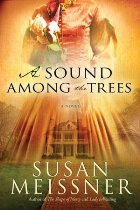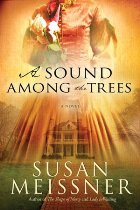 By Susan Meissner, Waterbrook Press, 352 pages
By Susan Meissner, Waterbrook Press, 352 pages
“Marielle and Caroline must already be working on the studio, she thought, and she grabbed a sweater off a hook by the kitchen door, slipped on her garden cligs, and stepped outside. A blast of warm air met her, so she tossed the sweater back onto a kitchen chair. The day was already on its way to becoming blistering. As she walked across the patio, she wondered if Carson was truly ready for the studio to be emptied of the last of its treasures. He said he was, but she had watched him prepare to leave for his weekend trip to Houston. She had watched him linger over saying good-bye to Marielle, his head turned toward the garden and what lay at the edge of it. It was as if he were saying good-bye to other things than just Marielle. It was probably best. There was nothing beautiful left in the studio. All the pretty things were long gone.”
Susan Meissner’s newest novel, A Sound Among the Trees, is the story of Marielle Bishop, a young woman who moves from her arid Arizona home to her new husband’s antebellum mansion, where the Virginia house itself seems to dictate the pain of the generations of women who have lived there. The current matriarch of Holly Oak is Adelaide, grandmother to Marielle’s new husband and great-grandmother to his two children, Hudson and Brette. Carson’s first wife and Marielle’s granddaughter was Sara, and although Sara has been dead for four years, Adelaide is reluctant to see Marielle join the folds of their deeply southern home.
According to family legend, young bride Susannah Page was a Civil War spy for the North – a horribly traitorous act for a Virginian with family roots that run deep. The psychological complexities that fester from such a long-held family tale haunt Adelaide and, ultimately, Marielle as Marielle seeks to partner with her new husband and assuage the ghosts of the past. High in the wall on Holly Oak’s north side is a cannonball half-buried in the stone: “The cannonball was more than just a reminder of what the house had suffered; it was a reminder of what the house had survived. [Adelaide] closed her eyes against the ache of suddenly realizing that it had always been this way, from the very moment the ball slammed into the house and did not crush it. And she had only ever seen the half of it.”
Jennie A. Camp

